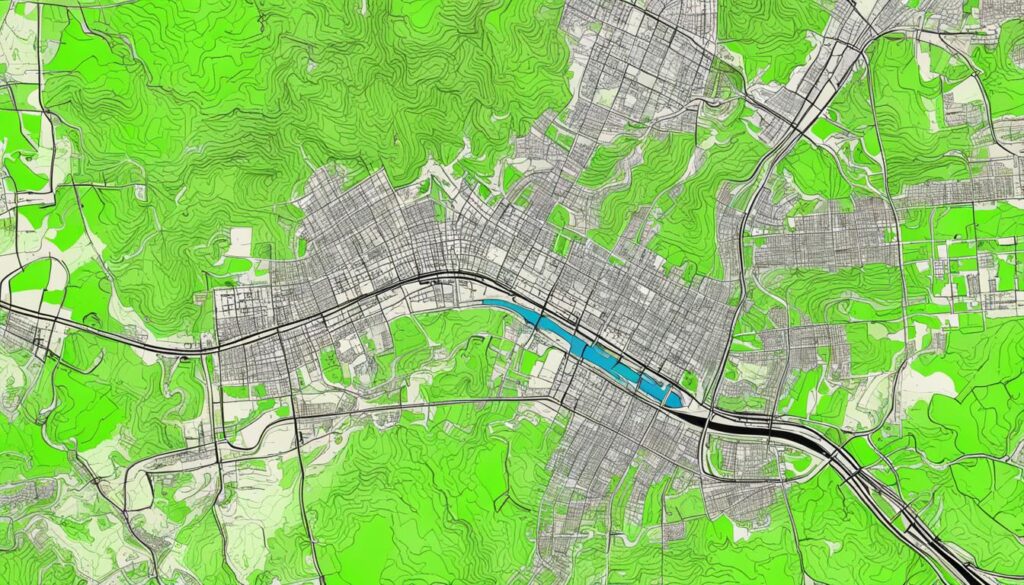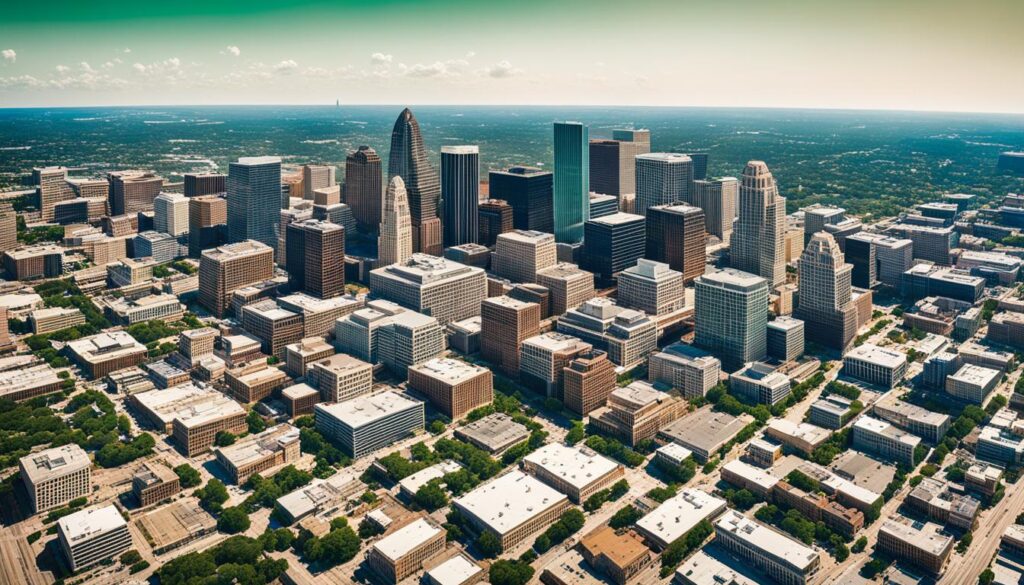Learn About Austin TX Elevation – Facts & Info
Austin, Texas, sits proudly at 30°16′2″N 97°44′35″W. It’s known for its lively culture, government centers, and schools. It’s also called the “Live Music Capital of the World.” The city started in 1839, and today, it’s the 11th largest in the U.S. and 4th in Texas. Austin is mainly in Travis County but stretches into Hays and Williamson counties. It’s 489 feet above sea level.
This height creates a vibrant landscape with lakes, rivers, and rolling hills. These features are all part of the Texas Hill Country.
Key Takeaways
- Austin, Texas, has a central elevation of 489 feet (149 meters).
- It has a population of 964,177 as of 2021.
- The Austin–Round Rock metropolitan area had a population of 2,473,275 in 2023.
- The city’s landscape includes lakes, rivers, and the Texas Hill Country.
- Austin is the 11th most populous city in the United States and the 4th in Texas.
Overview of Austin’s Geographic Features
Austin’s geographic makeup captivates with a mix of landscapes. It lies in Central Texas, part of the lively Texas Hill Country. The city’s elevation is 489 feet above sea level. This gives it varied terrains, from hills to flats. Austin’s complex topography is well-documented in its elevation survey.
Austin is home to 974,447 people and spans 326.51 square miles. It’s the heart of the Austin–Round Rock metro area. The city’s vast area reflects both natural beauty and urban development. Its location along Interstate 35 links it to other key Texas cities. This makes Austin a notable global city, per the Globalization and World Cities Research Network.
The city’s economy is strong, boasting a $222.1 billion GDP in 2022. It’s filled with prestigious companies like 3M, AMD, and Tesla. The University of Texas adds educational strength with over 50,000 students. This underscores the importance of Austin’s elevation in city planning.
Austin’s elevation supports a great lifestyle and business scene. Its varied elevations foster unique neighborhoods and natural areas. These features are beloved by residents, as shown in the Austin elevation survey.
Understanding Austin TX Elevation
Austin, Texas, stands out thanks to its varied elevations. The city sits on average 666 feet above sea level. This creates a unique mix of scenery across different areas.

General Elevation Range
The elevation in Austin varies from 425 feet to around 1,000 feet. This change in height makes the city’s backdrop exciting. Exploring from the low areas near the Colorado River to the higher hills in the west is an adventure.
Impact of the Balcones Fault
The Balcones Fault affects Austin’s landscape majorly. It divides the east’s flat lands from the hilly west. The western area, part of the Texas Hill Country, has beautiful hills and green spots. This adds charm to the city.
Elevation Variation Across the City
Austin’s elevation changes shape its growth and fun spots. For example, Shingle Hills stands at 1,253 feet, while Walnut Creek Metropolitan Park is at 702 feet. These elevation differences give each area its own look and feel, enriching the city’s charm.
Key Topographical Features of Austin
Austin is at 30°16′2″N 97°44′35″W, standing 489 feet high. It edges the Texas Hill Country, alive with 974,447 people. The area is vast, spanning 326.51 square miles. Sites like Lady Bird Lake and Barton Springs add charm. They improve the look and help with the ecosystem and city design.

The Balcones Fault line shapes Austin’s look, with its limestone hills and green areas. It makes the city’s ground go up and down, affecting nature and buildings. Austin mixes hills and flat areas over 326.51 square miles. This mix meets various building needs.
Deep looks into *austin elevation data* show the Highland Lakes’ importance. They offer fun and vital services like flood control. Need an *austin elevation certificate*? Waterloo Surveyors can help, with over twenty years of trusted service. They have certified experts and modern tools for precise surveys.
Austin combines natural beauty with strong infrastructure. It’s a place of innovation and looking after the planet. Big names like Apple and Tesla, plus the University of Texas, thrive here. This variety makes Austin special.
Austin Elevation Map and Topographical Resources
Austin, Texas, is showcased through detailed topographical maps. These maps are crucial for urban planning. They reveal the city’s landscape from Lake Travis, with an elevation of 912 feet, to Shingle Hills at 1,253 feet. This gives a clear picture of the city’s elevation and its various features.

Using Topographic Maps
Topographic maps are key for grasping Austin’s varied landscape. They cover areas like Abilene, Abernathy, and Amarillo. These maps show elevation shifts and terrain details, with data from as early as 1892 to 2013. Map scales from 1:24,000 to 1:250,000 show different levels of detail. Advances in technology mean these maps are more accurate than ever, using GeoPDFs that range from 2.5MB to over 31MB.
Online Elevation Tools
Technology has changed how we access topographical information. Online tools offer real-time data and interactive features. They are user-friendly too. These resources help explore Austin’s elevations, like Mount Bonnell, Lakeway, and Cat Mountain. With updated maps, users have everything they need for planning in areas of development, environmental care, and recreation.
| Location | Year | File Size (MB) |
|---|---|---|
| Abilene | 1957-2012 | 3.1-22.9 |
| Abernathy | 1957-2012 | 4.4-22.0 |
| Austin | 1925-2013 | 4.8-29.8 |
| Marathon Gap | 1968-2012 | 4.3-31.4 |
| Mansfield Dam | 1968-2013 | 2.6-26.7 |
Austin Above Sea Level: What You Need to Know
Austin has a charm that comes from its varied landscapes. The elevation shapes its neighborhoods and fun spots. It impacts outdoor activities, from water fun to hiking.
Comparing Different Neighborhoods
Austin’s elevation changes from 425 to about 1,253 feet above sea level. This difference makes each neighborhood unique. East Boggy Creek Greenbelt, at 472 feet, offers green spaces for everyone. Meanwhile, Shingle Hills rises to about 1,253 feet. It has stunning views and a cooler atmosphere.
Recreational Activities and Elevation
The varied elevations in Austin attract those who love being outdoors. For instance, Walnut Creek Metropolitan Park is around 702 feet high. It’s perfect for hikes and enjoying nature. The Highland Lakes, like Lake Travis and Lake Austin, have different heights. They are great for water sports and relaxing by the water.
Austin’s elevation is more than a number. It shapes how people have fun and live in the city.
Historical Context of Austin’s Elevation Changes
Austin has grown a lot since the 1830s. It started with about twelve people. Now, it has around 974,447 residents in 2022.

Development Over the Years
The city began near the Colorado River because it was a good place to live. Now, Austin has big places like the Texas State Capitol and the University of Texas. The University has over 50,000 students.
Knowing about Austin’s elevation has always been important. It helped make sure the city grew the right way. This was due to its different heights and landscapes.
Natural Events Influencing Elevation
Natural events really changed Austin’s elevation. Flash floods made it necessary to build dams. These dams created the Texas Highland Lakes and generate power. They shaped the city we see today.
There’s also been big snowstorms in 1937 and 2021. These events show how Austin’s elevation and weather can change.
Understanding Austin’s elevation helps in planning the city and managing disasters. The city’s history and natural events help us see how Austin has changed and grown.
Austin Elevation Data: Collection and Analysis
Gathering and analyzing Austin’s elevation data is crucial. It helps understand and manage the city’s varied landscape. This information is key for city planning, environmental projects, and disaster readiness.
Sources of Elevation Data
Austin’s elevation data comes from many reliable sources. A main method used is LiDAR LAS files, collected in 2011 for Austin and nearby areas. These files provide detailed land shapes, vital for precise mapping and studies.
- The Texas Water Development Board supports the data’s collection, ensuring its accuracy and usefulness.
- LiDAR data, found at the Texas Natural Resources Information System (TNRIS), is important for creating elevation and surface models.
- Even with full classification, the LiDAR data cannot always accurately remove buildings.
- The dataset is available under a Creative Commons Attribution 3.0 License, allowing wide use and application.
Practical Applications of Elevation Data
The Austin elevation survey has lots of uses. It helps with urban planning, addressing issues like construction, drainage, and nature conservation. Knowing the city’s elevation shapes helps make smart choices for its growth.
- Urban Planning: Trusted elevation data helps urban planners deal with the challenges of the land. It ensures projects are built right.
- Environmental Stewardship: Good elevation information supports efforts to protect nature. It guides actions to keep natural settings and control city spread carefully.
- Disaster Management: Elevation certificates are key for preparing for disasters. Knowing elevation patterns, officials can identify and handle flood risks. This protects communities.
| Key Data Points | Details |
|---|---|
| Elevation Range within City Limits | 400-1000 feet |
| LiDAR Data Acquisition | 2011 |
| Funding Entity | Texas Water Development Board |
| Available Elevation Models | DEM, DSM |
By using the Austin elevation survey and data, planners, environmentalists, and first responders can join forces. They can improve life for everyone living in Austin. Keeping accurate elevation data supports the city’s growth in a sustainable way.
Conclusion
In wrapping up our dive into Austin, TX’s topography, we see how its varied elevation shapes the city. At 489 feet above sea level, Austin showcases flat lands and rolling hills, especially when moving from east to west. This variety affects both nature and city life.
With 974,447 people, Austin is the US’s 11th largest city. It’s known for growth, economy, and culture. The Austin-Round Rock area, spanning 4,285.70 square miles, had roughly 2,473,275 people by July 2023. Highlights include the University of Texas at Austin, big tech firms, and being called the “Live Music Capital of the World”.
The city’s elevation ranges from 425 to about 1,000 feet. This shows the city’s geographic and climate diversity. From the lively downtown to calm Texas Hill Country edges, Austin’s elevation gives distinct views and qualities. Elevation maps and data reveal Austin’s evolving landscape in Central Texas.







